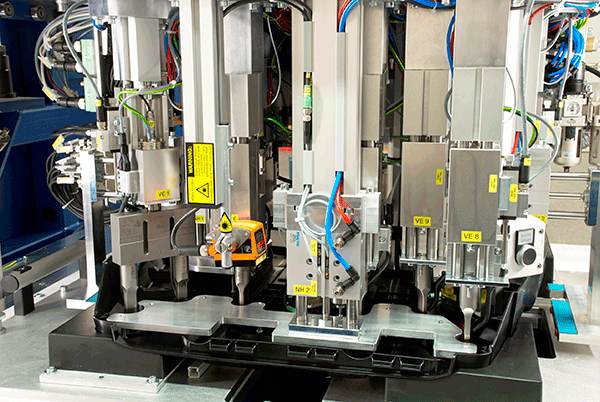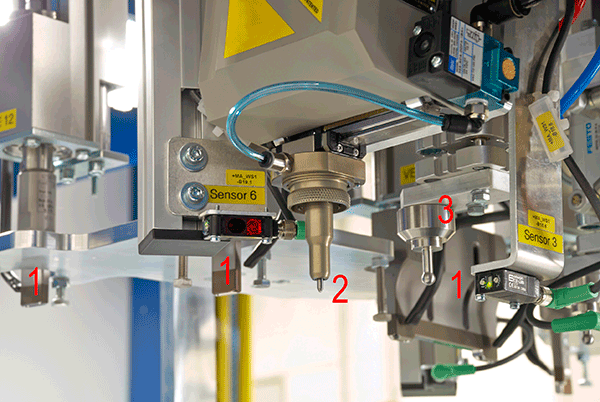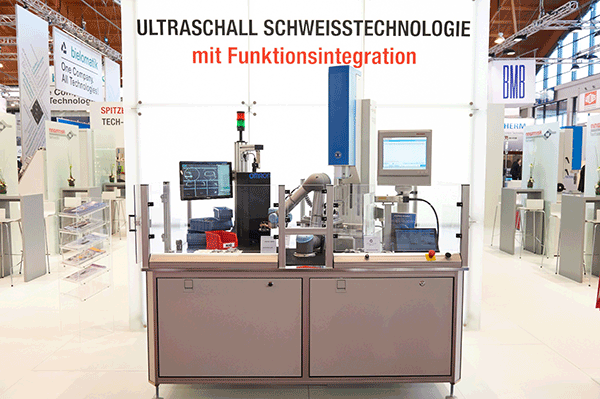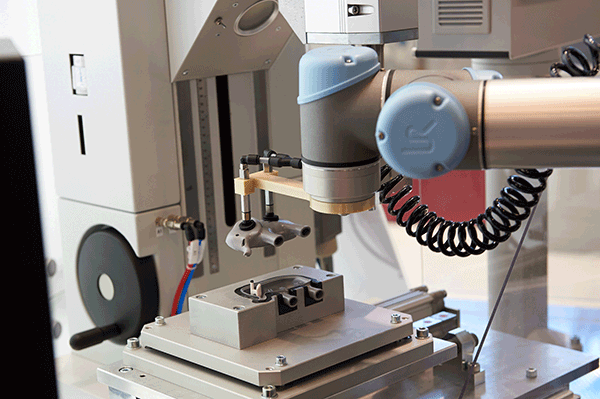Ultrasonic welding. In semi-automated multi-head machines, several processes are often jointly integrated to achieve high functional density in confined spaces. Parts assembly functions, component detection and sensing features, as well as various test processes are added to the actual joining process. The ultrasonic welding machine interconnects all auxiliary functions and creates interfaces.
The conventional concept of functional integration originates from design theory pursuing the goal of covering as many technical functions as possible with as few components as possible. Today, it is an indispensable principle of modern manufacturing processes: several process steps are combined in one production unit to improve the added value potential. There is no need to interrupt the process chain; this contributes to reducing unit costs and increasing production safety.
Implemented process interlinking with multi-head machines
Large, complex plastic parts are welded in multi-head machines. Integration of auxiliary functions has long been common practice, with obvious advantages: Plastic components with sensitive surfaces only have to be handled once when being inserted into the suitable fixture. Prevention of unnecessary part handling saves time and protects the product.
In the example shown (image 01 a and b), a multi-part engine cover is assembled and welded to the sound insulation mat. The work space comprises a large number of auxiliary functions. These include mechanical pressing-in of rubber dampers and scanning for correct fit, printing of a barcode label and verification of legibility, as well as permanent engraving of the component.

Functional integration in multi-head welding machine for automobile engine cover: entire tool change kit

Details of functional integration: Ultrasonic welding(1), scratch embossing equipment (2), mechanical press-in unit (3) and sensors
Identification becomes increasingly important for traceability
Today, identifying components, selecting pre-set parameters, and saving weld process data are basic requirements for the control architecture and ultrasonic generator software. This data is provided to an overriding PLC via conventional fieldbus interfaces and in a data base all information is allocated to the component. But not only documentation of weld process parameters is part of a complete traceability; single component marking and tagging is also crucial for identification. Herrmann Ultrasonics has made it their business to comply with requirements from various industries and to provide customized solutions. In future, expedited by the FDA (US), a Unique Device Identification (UDI) will be required for medical products. Depending on component design and the required durability, marking processes such as scratch embossing, laser, ink jet printing, and barcode labels are used. The customer can select the best suitable marking process, which is integrated as an auxiliary function into the overall concept of an ultrasonic welding machine.
Concept study at MD&M WEST 2015, booth # 3219
Herrmann Ultrasonics will demonstrate live the process interlinking of several production steps: a standard modular ultrasonic welder HiQ DIALOG, shown in combination with a touch-sensitive small-scale robot, a camera, and a marking device. The robot makes multi-axle handling of the applications possible. A camera checks the parts for their quality and completeness. After the weld process, all parts are individually marked, providing the current date and time and a unique application number.
Conclusion: In future, it will become easier to integrate other processes and auxiliary functions and thus supply supplementary functions from a single source. This not only applies to ultrasonic multi-head machines but also to manual work stations and ultrasonic welding systems. Customer demand is growing and interest at the trade show was great. Functional integration simplifies production monitoring and quality assurance processes. Herrmann Ultrasonics is going the extra mile and implementing further development of existing products to prepare them for “industry 4.0”.

Successful process-linking live exhibit at the booth of Herrmann Ultrasonics: Standard modular ultrasonic welder HiQ DIALOG with small-scale robot: handling, testing, welding, and marking of a weld part (here: toy elephant)

Detail – robot handles weld parts








Be the first to comment